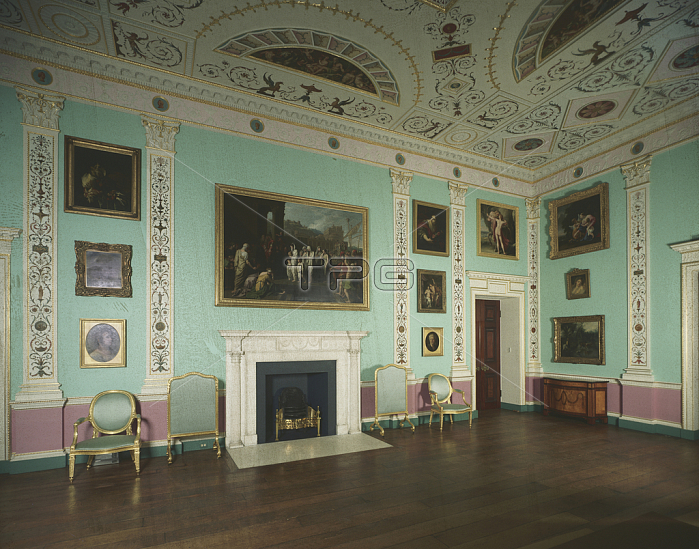
434253 Drawing Room from Lansdowne House, c.1766-75 (photo) by Adam, Robert (1728-92); Philadelphia Museum of Art, Pennsylvania, PA, USA; (add.info.: Designed by Robert Adam (1728-1792). Painted decoration by Giovanni Battista Cipriani (1727-1785) and Antonio Zucchi (1726-1795). Gilded by Joseph Perfetti (fl.1760-1778). This drawing room is an archetypal example of the work of Robert Adam, a Scottish architect and designer whose name has become synonymous with this style of neoclassical decoration. The room was originally situated on the ground floor of the grand London house that Adam designed for the third Earl of Bute in the early 1760s. Adam\'s original plans refer to it as the "Organ Drawing Room," the large recess being intended for Lord Bute\'s vastly expensive mechanical organ. In 1765, Lord Bute sold the unfinished house to William Petty Fitzmaurice, second Earl of Shelburne and later first Marquess of Lansdowne, with the provision that Adam be retained to continue work on the home. Adam was already well known to Lord Shelburne, whose father had employed the architect to remodel Bowood, his family\'s country estate in Wiltshire. (Shelburne, who served as Secretary of State and in 1783 concluded the Treaty of Paris granting independence to the United States, entertained Benjamin Franklin at Bowood on several occasions.) Lord Shelburne and his wife moved into the house in 1768, when it was in what Lady Shelburne described as "so unfurnishd a State." Yet by the time of Lady Shelburne\'s death and the end of Adam\'s employment by Lord Shelburne in 1771, the decoration of the drawing room remained incomplete and was evidently abandoned. Although the room\'s original furnishings do not survive today, it is known that Adam provided designs for a pier-glass and a semicircular pier-table, executed by John Gilbert; circular picture frames, executed by Sefferin Nelson; and a carpet, the design for which is in the collection of Sir John Soane\'s Museum in London. In 1929, Lord Shelburne\'s heirs sold the house to a group of investors. The room was acquired by the Philadelphia Museum of Art in 1931, when the front of the house, including the drawing room and the dining room (now in the Metropolitan Museum of Art), was slated for demolition to make way for a new street. With its fanciful decoration of scrolling and interlacing figures and foliage in the antique style, the drawing room from Lansdowne House in London is an archetypal example of the work of the architect Robert Adam, who so popularized this type of Neoclassical ornament that it has since been identified with his name. Adam provided his client, the Earl of Shelburne, with the designs for the room, and a team of artists and craftsmen executed Adam\'s plans in Shelburne\'s grand and fashionable house over a period of years. Yet when the house was first occupied in 1767, the drawing room was still unfinished. In fact, the room\'s most expensive decorations, the gilding and paintings, were completed only some four yers later. Lord Shelburne used the drawing room to display his important collection of paintings and antique sculpture as well as to entertain many of the most brilliant men of the age. Britain\'s prime minister in 1782-83, he helped negotiate the treaty that ended the American Revolution and was created 1st Marquis of Lansdowne for his services. Katherine B. Hiesinger, from Philadelphia Museum of Art: Handbook of the Collections (1995), p. 143. ); 穢 Philadelphia Museum of Art ; Gift of Graeme Lorimer and Sarah Moss Lorimer in memory of George Horace Lorimer, 1931; English, out of copyright.
| px | px | dpi | = | cm | x | cm | = | MB |
Details
Creative#:
TOP27063157
Source:
達志影像
Authorization Type:
RM
Release Information:
須由TPG 完整授權
Model Release:
No
Property Release:
No
Right to Privacy:
No
Same folder images:

 Loading
Loading